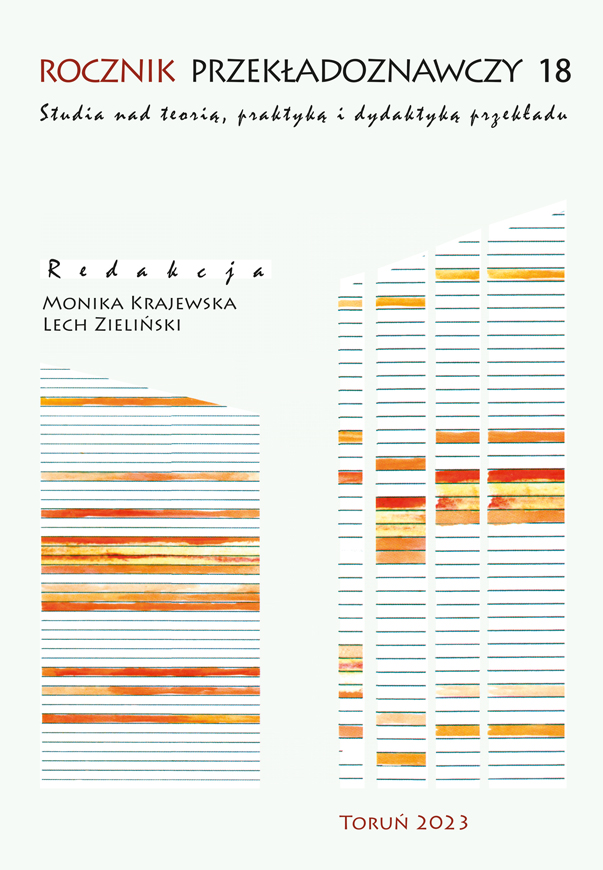Techniki tłumaczenia neologizmów absolutnych w niemieckim przekładzie Cyklu wiedźmińskiego Andrzeja Sapkowskiego
DOI:
https://doi.org/10.12775/RP.2023.002Słowa kluczowe
neologizm, techniki tłumaczeniowe, literatura fantastyczna, Andrzej SapkowskiAbstrakt
Niniejszy artykuł przedstawia wyniki analizy tłumaczenia na język niemiecki neologizmów autorskich z Cyklu wiedźmińskiego Andrzeja Sapkowskiego. Przeprowadzone badania nad 30 neologizmami absolutnymi, wyekscerpowanymi z tomów Miecz przeznaczenia, Ostatnie życzenie, Krew elfów, Czas pogardy, Chrzest ognia, Wieża Jaskółki, Pani Jeziora i Sezon burz potwierdziły, że tłumaczenie innowacji językowych jest zadaniem wymagającym indywidualnego podejścia ze strony tłumacza, szczególnie jeśli dotyczy ono tak unikalnego materiału, jakim jest literatura fantastyczna. W dalszej perspektywie wykazano, że teoretyczne propozycje translatorskie (transplantacja, kreacja, imitacja i neutralizacja) znajdują potwierdzenie w praktyce przekładu.
Bibliografia
Sapkowski A., 1996, Chrzest ognia, Warszawa.
Sapkowski A., 1995, Czas pogardy, Warszawa.
Sapkowski A., 2008, Das Erbe der Efen, tłum. Erik Simon, Munchen.
Sapkowski A., 2008, Das Schwert der Vorsehung, tłum. Erik Simon, Munchen.
Sapkowski A., 2007, Der letzte Wunsch, tłum. Erik Simon, Munchen.
Sapkowski A., 2010, Der Schwalbenturm, tłum. Erik Simon, Munchen.
Sapkowski A., 2011, Die Dame vom See, tłum. Erik Simon, Munchen.
Sapkowski A., 2009, Die Zeit der Verachtung, tłum. Erik Simon, Munchen.
Sapkowski A., 2009, Feuertaufe, tłum. Erik Simon, Munchen.
Sapkowski A., 1994, Krew elfów, Warszawa.
Sapkowski A., 1992, Miecz przeznaczenia, Warszawa.
Sapkowski A., 1993, Ostatnie życzenie, Warszawa.
Sapkowski A., 1999, Pani Jeziora, Warszawa.
Sapkowski A., 2013, Sezon burz, Warszawa.
Sapkowski A., 1997, Wieża Jaskółki, Warszawa.
Sapkowski A., 2015, Zeit des Sturms, tłum. Erik Simon, Munchen.
Augustyn R., 2010, Neologismen in Science-Fiction - eine kontrastive Analyse der Ubersetzungsverfahren am Beispiel des Romans Revenge of the Sith, “Lubelskie Materiały Neofilologiczne”, nr 34, s. 35-50, http://cejsh.icm.edu.pl/cejsh/element/bwmeta1.element.desklight-b1dd4261-6318-4e06-883a-61f19050fd61.
Handke R., Jęczmyk L., Okólska B., 1989, Spór o SF: antologia szkiców i esejów o science fiction, Poznań.
Hejwowski K., 2006, Kognitywno-komunikacyjna teoria przekładu, Warszawa.
Heller K., Herberg D., Lange Ch., Schnerrer R., Steffens D., 1988, Theoretische und Praktische Probleme der Neologismenlexikographie: Uberlegungen und Materialien zu einem Worterbuch der in der Allgemeinsprache der DDR gebrauchlichen Neologismen, Berlin.
Herberg D., Kinne M., 1998, Neologismen, Heidelberg.
Maurer N., 2015, Adamov’s Alienation Effect: Showing the Absurdist Slant of Epic Theatre Aesthetic, “Oregon Undergraduate Research Journal”, nr 9.1, s. 76-85, DOI: 10.5399/uo/ourj.9.1.6.
Newmark P., 1988, A Textbook of Translation, London New York.
Nodelman P., 1981, The Cognitive Estrangement of Darko Suvin, “Children’s Literature Association Quarterly”, nr 5, s. 24-27, DOI: https://doi.org/10.1353/chq.0.1851.
Salich H., 2018, Techniki i strategie tłumaczenia neologizmów autorskich. Polska literatura fantastyczna i fantastycznonaukowa w przekładach angielskich, Warszawa.
Schippan T., 2002, Lexikologie der deutschen Gegenwartssprache, Tubingen. Smółkowa T., 2001, Neologizmy we współczesnej leksyce polskiej, Kraków.
Neologizm [hasło:], w: Wielki Słownik Języka Polskiego online, https://wsjp.pl/ haslo/podglad/67021/neologizm (dostęp: 8.12.2022).
Pobrania
Opublikowane
Numer
Dział
Licencja
Prawa autorskie (c) 2024 Manuela Graf

Utwór dostępny jest na licencji Creative Commons Uznanie autorstwa – Bez utworów zależnych 4.0 Międzynarodowe.
Statystyki
Liczba wyświetleń i pobrań: 1096
Liczba cytowań: 0



